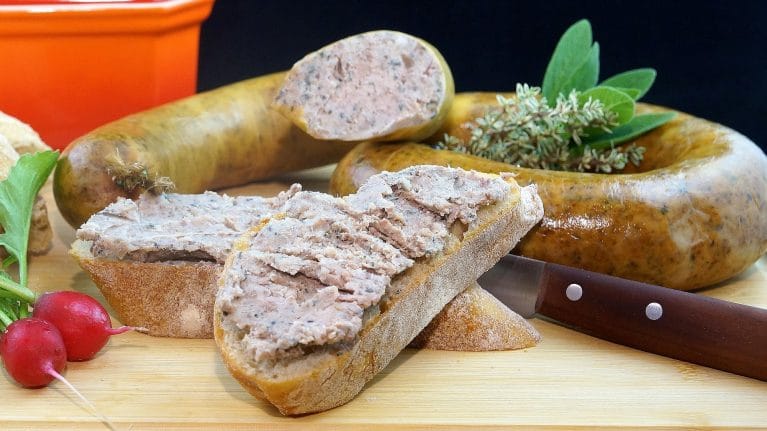25 Vitamin B6 Foods for a Much Healthier Brain in 2024

Vitamin B6 is one of the eight vitamins of the vitamin B complex. All eight vitamins are involved in converting foods into energy needed for the normal functioning of the body. In addition to this function, vitamin B6 has many other vital roles. Therefore, it is crucial to consume enough vitamin B6 foods to feel good and stay healthy. Now, let’s dive deeper into the matter.
What Is Vitamin B6?
Vitamin B6 is a water-soluble vitamin, meaning that the body doesn’t store it in large amounts. Any excess that the body doesn’t need is excreted in the urine. That’s why it is of great importance to consume vitamin B6 foods every day.
The term vitamin B6 covers six different compounds. The body converts them into the active forms of this vitamin — pyridoxal phosphate, which plays a vital role in the body’s functioning.
Vitamin B6 Benefits
This vitamin takes part in over 100 enzyme reactions, which are mostly related to protein metabolism. It also plays an essential role in other metabolic processes involving amino acids, carbohydrates, and lipids.
Another vitamin B6 function is being involved in the production of hemoglobin, a protein that transports oxygen to our cells. If hemoglobin levels are low, our cells don’t get enough oxygen, and we are at risk of developing anemia. Vitamin B6 can be used for preventing and treating this blood disorder.
One of the B6 vitamin benefits is the production of neurotransmitters in the brain. Therefore, it is vital for healthy brain development. In addition to carrying signals from one neuron (nerve cell) to another, neurotransmitters contribute to the production of hormones influencing our mood and sleep cycle.
According to some research, people with low levels of vitamin B6 are at higher risk of heart disease. Since vitamin B6 reduces homocysteine levels in the blood, a vitamin B6 supplement may prevent clogged arteries and decrease the risk of heart disease.
Thanks to lowering homocysteine levels, vitamin B6 may also prevent eye diseases, primarily age-related macular degeneration (AMD). This type of vision loss has been related to high homocysteine levels. Thankfully, a sufficient vitamin B6 dosage can lower the risk of this condition.
Vitamin B6 is an ingredient in some medications used for treating morning sickness. This condition involves nausea and vomiting during the first months of pregnancy. However, it’s crucial to talk to your doctor before using any drugs while pregnant.
Pyridoxine Foods
Generally speaking, meat, fish, and potatoes are particularly rich in this nutrient. Breakfast cereals and other types of foods are often fortified with this compound, too. In other words, a wide range of food contains vitamin B6.
As low levels of vitamin B6 can cause both physical and mental problems, it’s of high importance to consume enough foods rich in it. Below, you can find a vitamin B6 foods list, which will hopefully help you prepare your daily menu.
Beef Liver
Beef liver is packed with vitamin B6. For example, three ounces of beef liver will provide you with 53% of the vitamin’s DV. Ground beef is also one of the pyridoxine sources, as a 3-ounce serving of ground beef can cover 16% of its DV. Overall, beef is rich in zinc, protein, and iron.
Chicken
Other types of meat belong to foods rich in vitamin B6, too. For example, a 3.5-ounce serving of lean chicken breast covers 54% of the vitamin’s DV. Moreover, a roast chicken thigh gets you 33% of the pyridoxine’s DV. As for the meat’s health benefits, chicken meat, in particular, builds muscles, helps with weight loss, promotes heart health, and strengthens the bones.
Turkey
Turkey meat is undoubtedly a valuable addition to pyridoxine foods. From two thick slices (2.9 ounces) of turkey, you will get around 49% of vitamin B6’s DV. In addition, turkey is rich in riboflavin, niacin, selenium, zinc, phosphorus, and vitamin B5.
Salmon
Fish managed to land itself a spot among vitamin B6 foods, too. As little as three ounces of cooked sockeye salmon serve 35% of the vitamin’s DV. What’s more, this fish belongs to vitamin B12 foods, and it’s an excellent source of beneficial omega-3 fatty acids, phosphorus, potassium, selenium, and zinc.
Tuna
Our list of most essential pyridoxine foods cannot be complete without tuna. Three ounces of cooked, yellowfin fresh tuna covers 53% of the vitamin’s DV. This fish is also rich in minerals, such as magnesium, phosphorus, and potassium. That said, tuna is high in cholesterol, so you should eat it in moderation.
Chickpeas
Besides meat and fish, there are a variety of vitamin B6 foods vegetarian people can enjoy. Chickpeas are one of them as they are rich in this essential nutrient. As a matter of fact, in one cup of chickpeas, you will get 65% of vitamin B6’s DV. Additionally, studies have shown that eating more chickpeas helps with bowel movement and lowers cholesterol.
Potatoes
What is pyridoxine found in? What do I add to my vegan or vegetarian diet? Don’t get discouraged. To our delight, many vegetables have high vitamin B6 content, including potatoes.
Notably, one cup of boiled potatoes will provide you with 25% of the vitamin’s DV. Moreover, this veggie is an excellent source of other B vitamins, such as niacin and thiamine, and some healthy minerals, like potassium and copper.
Acorn Squash
Acorn squash is also one of the foods high in vitamin B6. Namely, one cup of cooked acorn squash covers 20% of the vitamin’s DV. In addition, this type of winter squash is rich in vitamin A, potassium, magnesium, and manganese. Therefore, it promotes overall health and protects against heart disease and type 2 diabetes.
Spinach
Spinach is a green, leafy vegetable deserving of the spot on the list of foods with vitamin B6. Notably, half a cup of boiled, chopped, and frozen spinach will cover 6% of the vitamin’s DV. This veggie is highly nutritious as it contains vitamin K, vitamin A, vitamin E, folate, calcium, iron, magnesium, and other vitamins and minerals.
Onions
Onions should be your go-to when searching for vitamin B6 vegetables. Impressively, as little as half a cup of chopped onions gets you 6% of this vitamin’s DV. Furthermore, they contain antioxidants and compounds, fighting inflammation, decreasing triglycerides, reducing cholesterol levels, and lowering the risk of heart disease.
Black-Eyed Peas
Black-eyed peas are yet another veggie source of vitamin B6. Notably, if you eat one cup of cooked black-eyed peas, you will cover 10% of the vitamin’s DV. In addition, they contain vitamin C, vitamin A, vitamin K, thiamine, protein, and manganese. Also, they may aid in weight loss, promote digestive health, and improve heart health.
Pistachio Nuts
Vitamin B6-rich foods also include some nuts. For example, 3.5 ounces of pistachio nuts cover 100% of this vitamin’s DV. Furthermore, these nuts have a high thiamine content. Pistachio nuts are an excellent source of numerous minerals, including copper, manganese, and phosphorus.
Chestnuts
Chestnuts are also good sources of vitamin B6. As a matter of fact, in ten kernels of roasted chestnuts, you will get 25% of the vitamin’s DV. They are also rich in other B vitamins, such as folate and thiamine. When it comes to minerals, they are an excellent source of manganese, copper, and potassium.
Butternut Squash
Butternut squash is another kind of winter squash that belongs to the B6 vitamin foods. For example, one cup of cooked butternut squash covers 13% of the vitamin’s recommended dietary intake (RDI). It is also a rich source of vitamin E, calcium, and magnesium.
Bananas
Now, let’s talk about vitamin B6 fruits. First on our list are most people’s favorite — bananas. One medium banana contains approximately 33% of the vitamin B6’s DV. Moreover, this fruit is a rich source of vitamin C and dietary fiber, and it helps with digestive health, heart health, weight loss, and blood sugar levels.
Avocados
Avocados have numerous health benefits, and they are an excellent vitamin B6 food source. For instance, you can cover approximately 30% of the vitamin’s DV by eating one avocado. In addition, this fruit will provide you with vitamin C, vitamin K, and folate.
Watermelon
Watermelon is yet another delicious B6 vitamin food. A cup of raw watermelon serves about 6% of the vitamin B6’s DV. Some other benefits of watermelons include improving heart health, relieving muscle soreness, and lowering inflammation.
Elderberries
Elderberries are also among the foods that contain vitamin B6. Notably, one cup of this fruit serves 20% of the vitamin’s DV. Furthermore, these berries are very healthy as they have vitamin A, vitamin C, iron, and potassium. Elderberries might also help with inflammation and stress.
Mangoes
Mangoes are vitamin B6-rich food, excellent for boosting the immune system. Notably, 3/4 of a cup of mango pieces covers 8% of vitamin B6’s DV. Moreover, this fruit boasts a high vitamin C content, and it is a rich source of vitamin A.
Pineapples
We simply cannot omit pineapples when talking about vitamin B6 foods’ sources. With one cup of pineapple chunks, you will cover 11% of the vitamin’s DV. What’s more, not only does pineapple belong to vitamin B6-rich fruits, but it is also a great source of dietary fiber, vitamin C, thiamine, manganese, and copper.
Apricots
Another vitamin B6 source is apricot. Namely, in one cup of apricots, you will get 5% of the vitamin’s DV. Besides being a natural source of vitamin B6, apricots boast containing vitamin A and potassium. Furthermore, they may promote eye health, protect the liver, and boost skin health.
Grapes
Grapes are yet another valuable addition to foods that have vitamin B6. Namely, one cup of red or green grapes covers 6% of vitamin B6’s DV. Overall, grapes are very healthy since they are also rich in vitamins C and K, and they may protect against cancer, cardiovascular disease, and eye problems.
Marinara Sauce
Good sources of B6 also include marinara sauce. As a matter of fact, a cup of ready-to-serve marinara sauce provides 35% of this vitamin’s DV. Moreover, it improves the skin and bones, promotes healthy hair, and alleviates chronic pain.
Waffles
Waffles are also a food rich in vitamin B6. For example, a ready-to-heat plain waffle serves approximately 18% of the vitamin’s DV. In addition, waffles are rich in vitamin B12, iron, phosphorus, thiamine, riboflavin, and niacin.
Cottage Cheese
To our delight, this cheese also belongs to foods with pyridoxine. For instance, a cup of 1% low-fat cottage cheese covers 12% of the vitamin’s DV. It’s also rich in B12, phosphorus, calcium, and selenium. In other words, this cheese promotes heart health, maintains blood sugar levels, improves digestion, and supports bone health.
Recommended Daily Intake
In the Dietary Reference Intakes provided by the Food and Nutrition Board (FNB), you can find daily intake recommendations for all the vitamins and minerals, including the recommended vitamin B6 dosage. Below you can have a look at the recommended dietary allowances (RDA) for vitamin B6.
RDA is an average daily intake that should cover the nutrient requirements of most healthy people. If your diet lacks foods rich in this nutrient, you may endanger your health. However, taking too much vitamin B6 is not good either as there are some adverse vitamin B6 side effects.
The RDAs for vitamin B6, depending on age and sex, are as follows:
- from birth to 6 months — 0.1 mg
- from 7 to 12 months — 0.3 mg
- from 1 to 3 years — 0.5 mg
- from 4 to 8 years — 0.6 mg
- from 9 to 13 years — 1.0 mg
- from 14 to 18 years — 1.3 mg (male) and 1.2 mg (female)
- from 19 to 50 years — 1.3 mg (male) and 1.3 mg (female)
- 50+ years — 1.7 mg (male) and 1.5 (female)
However, pregnant women are recommended to take 1.9 mg of vitamin B6. Also, during lactation, the RDA for this vitamin is 2.0 mg.
Vitamin B6 Deficiency
People are rarely deficient only in vitamin B6. It is much more common to have low levels of several B vitamins.
Note that people with a deficiency in vitamin B6 show various symptoms, including skin rashes, cracked and sore lips, and a swollen or inflamed tongue. Other vitamin B6 deficiency symptoms are tiredness, low energy levels, and a weakened immune system. Low concentrations of this nutrient may also cause depression, anxiety, and irritability.
If you have healthy eating habits, you don’t need to worry about B6 vitamin deficiency. However, certain diseases can cause a lack of this vitamin. For example, kidney diseases and homocystinuria may result in low levels of this vitamin. Also, malabsorption syndromes, such as Crohn’s disease and celiac disease, can lead to low concentrations of vitamin B6. In addition, a deficiency in this nutrient can result from the long-term use of some medications.
Who Should Take a Vitamin B6 Supplement?
People with some medical issues might need to increase their daily intake of this vitamin. It’s worth mentioning that a high vitamin B6 intake can cause some severe health conditions, so always consult your physician about dietary supplementation.
People suffering from kidney diseases are likely to have low concentrations of vitamin B6. Also, those who have received a kidney transplant often show symptoms of vitamin B6 deficiency. In addition, low levels of vitamin B6 are characteristic of people with rheumatoid arthritis.
Other autoimmune disorders, such as celiac disease and inflammatory bowel disease, are also connected with low nutrient concentrations. Alcoholics are another group at risk of developing a deficiency in vitamin B6. That’s why they are often advised to take vitamin supplements.
Vitamin B6 Toxicity
There is no evidence that food sources of vitamin B6 cause adverse effects. However, high doses of pyridoxine, a form of vitamin B6, can cause severe neurologic symptoms.
In fact, excessive intakes of this vitamin may also lead to vitamin B6 side effects, like
- painful skin lesions
- photosensitivity
- problems with the gastrointestinal tract, including heartburn and nausea
So, the FNB has defined the tolerable upper intake levels (ULs) for vitamin B6, which differ depending on age. The ULs are not meant for those who receive this vitamin as a medical treatment.
Conclusion
Vitamin B6 is vital for the body. For example, one crucial vitamin B6 function is to keep our nervous system healthy. That’s why it’s critical to develop healthy eating habits and include various foods that contain this precious nutrient in our diet. Remember that it’s always best to rely on natural sources of this vitamin.
FAQs
What does vitamin B6 do?
Vitamin B6 has a vital role in more than 100 enzyme reactions. It is also involved in protein, carbohydrate, amino acid, and lipid metabolism. This vitamin is responsible for the production of hemoglobin and brain development as it promotes the production of neurotransmitters. Also, it can reduce the risk of heart disease, and it’s used for preventing and treating morning sickness during pregnancy.
Does vitamin B6 help you sleep?
Vitamin B6 can affect your sleeping cycle as it regulates the level of tryptophan, an essential amino acid responsible for relaxation and sleep. Moreover, vitamin B6 converts tryptophan to serotonin, a neurotransmitter that also regulates sleep patterns.
What is the normal range for vitamin B6?
Recommended daily intakes depend on age and sex. Both men and women aged from 19 to 50 should take 1.3 mg a day. However, men older than 50 need 1.7 mg a day, while women of that age need 1.5 mg a day. Since high doses of vitamin B6 taken as a supplement might have side effects, both men and women older than 19 shouldn’t take more than 100 mg a day.
What causes too much vitamin B6?
Using B6 as a supplement in appropriate doses is safe.
Be that as it may, too much B6 from supplements may lead to:
- painful and disfiguring skin lesions
- numbness
- decreased muscle control or coordination of voluntary movements
- reduced ability to sense extreme temperatures or pain
- heartburn and nausea
- sensitivity to sunlight
What are the symptoms of too much vitamin B6?
High intakes of vitamin B6 as a supplement can cause several adverse effects, including severe neurological symptoms. What’s more, high doses may also result in skin lesions, photosensitivity, and gastrointestinal problems, such as nausea and heartburn.
What are the symptoms of low vitamin B6?
Even though deficiency of this nutrient is uncommon, it’s still possible. Some of the signs and symptoms of vitamin B6 deficiency include anemia, seizures, depression, a weakened immune system, and confusion. Also, people can experience peripheral neuropathy with numbness, tingling, and pain in the feet and hands.
What fruit has vitamin B6?
A variety of fruits is rich in vitamin B6. For example, bananas, mangoes, avocados, and pineapples are all excellent natural sources of B6. Some berries, such as elderberries, gooseberries, and blueberries, are high in this nutrient, as well. Vitamin B6 can also be found in dried fruit, like dried apricots and prunes.
What foods contain vitamin B6?
Vitamin B6 is found in many foods. Fish, beef liver, and other common meats, like chicken and turkey, are rich sources of this vitamin. Other vitamin B6 foods include potatoes, green peas, winter squash, bananas, and other fruits and vegetables. This nutrient is also often added to certain types of foods, such as cereals.







A couple of years ago I had severe Restless Legs Syndrome after taking a vit B6 supplement( very high dose subscribed by doctors). It stopped after a few days whit not taking this supplement anymore. But now I have it again at night since eating keto. I ate lots of pistachio nuts before going to bed. Now reading this info I can see why!
Thanks!
Hi Peter!
We’re very happy our article helped you!